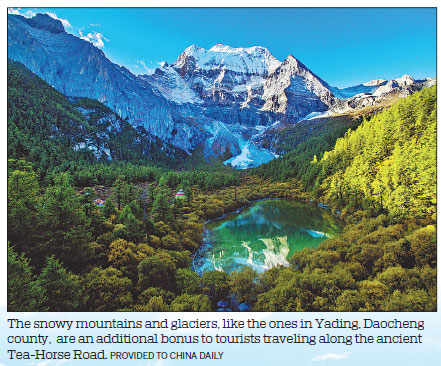Authorities designate ancient passageways as trail routes for tourists
"Alas! So dangerous and moreover so high!
The road to Shu is harder than that to the sky!"
In his poem Hard Is the Road to Shu, famous Tang Dynasty (618-907) poet Li Bai thought the roads from Qin - today's Shaanxi province - to Sichuan, which is called Shu in ancient times, were among the hardest throughout the country.
They were so difficult that even "yellow cranes will find it hard to fly across and monkeys will discard any effort to climb over".
Hard as they were, however, there are several passageways connecting Sichuan to the rest of the country and overseas for thousands of years.
Back in history, the passageways were traveled by many painstaking traders, soldiers and monks carrying the missions to spread religions.
Today, two of the passageways have been designated by Sichuan authorities as the routes for tourists to explore the history and cultures and enjoy the scenic mountains and rivers near the roads.
One of the routes is "the road to Shu" as described in Li Bai's poem.
Standing at the hub of the route is the city of Guangyuan in the north of Sichuan, bordering Shaanxi province.
Near today's highways that make travel much easier, there are still a lot of ancient plank roads built along the cliffs.
In Li Bai's imagination, the plank roads were built with great effort:
"The earth collapsed, mountains broke and brave men were dead.
The skyward ladders with cliff plank roads were connected."
The plank roads are silent witness to many historical events: the transport of grains from Sichuan to help the Qin State's conquest of the country in the late third century BC, the northern expeditions by the Shu army led by prime minister Zhuge Liang in the AD third century, to just name a few.
All the travelers had to cross the Jianmen Pass, or Jiange, when they embarked on this route.
The unparalleled strategic position of the pass was also mentioned in Li's poem:
"Jiange is a stronghold very lofty and steep,
Which ten-thousand fail to seize with one man to keep."
Another passageway on Sichuan's latest tourist routes is the ancient Tea-Horse Road, the southern Silk Road that connected China to its neighboring regions in South Asia and Southeast Asia.
The route starts in the city of Ya'an, which is the hub for Sichuan's international tea trade even to this date.
Before it reaches the overseas, the route goes through the regions that are mostly inhabited by China's ethnic people including the Tibetan, Qiang, Yi and Naxi.
Again, the rich ethnic cultures and imposing landscapes are additional bonus to travelers on this route: for instance, the ancient residences and watchtowers in Danba county, the pastoral life in Xinduqiao township in Kangding city.


(China Daily 07/23/2019 page18)














